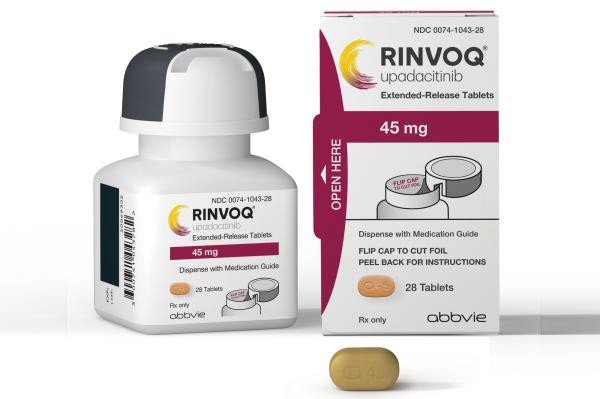
Contents
upadacitinib
Upadacitinib is a medication used to treat rheumatoid arthritis and autoimmune disorders. Autoimmune diseases are a result of an immune system that attacks the body’s own tissue, causing inflammation and damage. Upadacitinib is a disease-modifying antirheumatic drug (DMARD) and a Janus kinase (JAK) inhibitor, a small molecule drug that can alter intracellular functions to slow down the disease.
Janus kinase inhibitors block Janus kinase enzymes and their pro-inflammatory signaling pathways. Janus kinases are intracellular enzymes known as protein tyrosine kinases that stimulate immune function and blood cell production. JAK-mediated pro-inflammatory signaling plays a key role in autoimmune disorders.
There are four types of Janus kinases, JAK1, JAK2, JAK3, and TYK2. Janus kinases add a phosphate group (phosphorylate) and activate signal transducers and activators of transcription (STATs), regulating gene expression and intracellular activity. Upadacitinib prevents phosphorylation and activation of STATs, reducing inflammation and immune response.
The uses of upadacitinib include:
FDA-approved:
- Moderate to severe active rheumatoid arthritis
- Active psoriatic arthritis
- Moderate to severe active ulcerative colitis
- Moderate to severe active Crohn’s disease
- Active ankylosing spondylitis
- Active non-radiographic axial spondyloarthritis with objective signs of inflammation
Adult and Pediatric:
- Atopic dermatitis in patients 12 years or older
Orphan designation
Warnings
- Do not use upadacitinib in patients with hypersensitivity.
- Upadacitinib treatment is associated with serious and sometimes fatal infections. The most frequent serious infections include pneumonia and cellulitis. Opportunistic infections include tuberculosis, multi-dermatomal herpes zoster, oral/esophageal candidiasis, and cryptococcosis. Avoid use of upadacitinib in patients with active serious infections. Consider risk and benefit before initiating treatment in patients with chronic and recurrent infections, exposed to tuberculosis (TB), with a history of a serious or opportunistic infection, with underlying conditions that predispose to infection, or staying in/traveling to places of endemic TB or fungal infections (mycoses). Do not initiate upadacitinib in patients with active TB infection. Initiate treatment for latent TB before starting upadacitinib therapy. Consider anti-TB treatment for patients with a history of latent or active TB or negative latent TB test with risk factors. Monitor patients for signs and symptoms of active TB infection during and after upadacitinib treatment.
- Although patients positive for hepatitis C antibody or viral RNA, and patients positive for hepatitis B surface antigen or viral DNA were excluded from clinical trials, hepatitis B reactivation was reported in some patients. Consult with a liver specialist if hepatitis B viral DNA is detected.
- All-cause mortality including sudden cardiovascular death. Consider individual risks and benefits before initiating or continuing upadacitinib. Lymphoma and other malignancies (excluding nonmelanoma skin cancer [NMSC]) have been reported. Consider individual risks and benefits before starting/continuing upadacitinib, particularly in current or past smokers, patients with known malignancy, or those who develop a malignancy during treatment. NMSC has occurred in some patients treated with upadacitinib. Perform periodic skin examinations and advise patients to protect themselves from the sun. Consider individual risks and benefits before starting or continuing upadacitinib. Educate patients on symptoms of serious cardiovascular events. Discontinue upadacitinib treatment in patients who have experienced stroke or MI.
- Avoid use of upadacitinib in patients with an increased risk for thrombosis. Monitor patients for symptoms, evaluate the patient, discontinue upadacitinib and initiate appropriate treatment if thrombosis develops.
- Monitor patients with an increased risk for GI perforation, such as patients with diverticulitis or those taking concurrent non-steroidal anti-inflammatory drugs (NSAIDs) or corticosteroids. Evaluate patients who develop new onset of abdominal pain for early identification of GI perforation.
- Evaluate complete blood count at baseline and periodically thereafter. Avoid initiating treatment in patients with anemia, neutropenia, or lymphopenia and interrupt treatment in patients whose counts drop during treatment.
QUESTION
What are the side effects of upadacitinib?
Common side effects of upadacitinib include:
- Upper respiratory tract infection
- Bronchitis
- Pneumonia
- Cough
- Fever
- Nausea
- Abdominal pain
- Gastroenteritis
- Gastrointestinal perforation
- Infections, including serious infections
- Cellulitis
- Tuberculosis
- Opportunistic infections
- Herpes zoster
- Herpes simplex
- Oral candidiasis
- Headache
- Influenza
- Influenza-like illness
- Hypersensitivity reactions
- Rash
- Acne
- Folliculitis
- Muscle pain
- Fatigue
- Deep vein thrombosis
- Pulmonary embolism
- Liver injury
- Impaired bile flow
- Elevation of liver enzymes
- Increase in alkaline phosphatase
- Increase in bilirubin
- Increase in blood fats
- Elevation of triglycerides
- Increase in cholesterol levels
- Increase in creatine phosphokinase
- Blood disorders
Call your doctor immediately if you experience any of the following symptoms or serious side effects:
- Fast or pounding heartbeats, fluttering in your chest, shortness of breath, and sudden dizziness;
- Severe headache, confusion, slurred speech, severe weakness, vomiting, loss of coordination, feeling unsteady;
- Severe nervous system reaction with very stiff muscles, high fever, sweating, confusion, fast or uneven heartbeats, tremors, and feeling like you might pass out;
- Serious eye symptoms including blurred vision, tunnel vision, eye pain or swelling, or seeing halos around lights.
This is not a complete list of all side effects or adverse reactions. Call your doctor or report side effects to the FDA.


